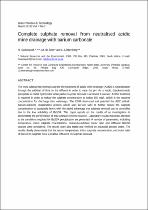 ResearchSpace
ResearchSpace
Complete sulphate removal from neutralised acidic mine drainage with barium carbonate
JavaScript is disabled for your browser. Some features of this site may not work without it.
- ResearchSpace
- →
- Research Publications/Outputs
- →
- Journal Articles
- →
- View Item
| dc.contributor.author |
Swanepoel, H

|
|
| dc.contributor.author |
De Beer, Morris

|
|
| dc.contributor.author |
Liebenberg, L

|
|
| dc.date.accessioned | 2013-01-08T14:45:28Z | |
| dc.date.available | 2013-01-08T14:45:28Z | |
| dc.date.issued | 2012-03 | |
| dc.identifier.citation | Swanepoel, H., De Beer, M. and Liebenberg, L. 2012. Complete sulphate removal from neutralised acidic mine drainage with barium carbonate. Water Practice & Technology, vol. 7(1). | en_US |
| dc.identifier.issn | 1751-231X | |
| dc.identifier.uri | http://www.iwaponline.com/wpt/007/wpt0070003.htm | |
| dc.identifier.uri | http://hdl.handle.net/10204/6415 | |
| dc.description | Copyright: 2012 IWA Publishing. This is an ABSTRACT ONLY. The definitive version is published in Journal of Water Practice & Technology, vol. 7(1). | en_US |
| dc.description.abstract | The most widespread method used for the treatment of acidic mine drainage (AMD) is neutralisation through the addition of lime to the effluent in order to raise the pH. As a result, dissolvedmetals precipitate as metal hydroxides while partial sulphate removal is achieved. However, further treatment is required in order to reduce the sulphate concentration to below 500 mg/l, which is the required concentration for discharge into waterways. The CSIR developed and patented the ABC (alkali-barium-calcium) Desalination process which uses barium salts to further reduce the sulphate concentration to acceptable levels with the added advantage that sulphate removal can be controlled due to the low solubility of BaSO4. This paper reports on the results of an investigation to demonstrate the performance of this sulphate removal reaction. Laboratory results that draw attention to the conditions required for BaSO4 precipitation are presented. A number of parameters, including temperature, initial sulphate concentration, barium-to-sulphate molar ratio and different BaCO3 sources were considered. The results were also tested and verified on industrial process water. The results clearly demonstrate that the reactor temperature, initial sulphate concentration, and molar ratio of barium to sulphate have a positive influence on sulphate removal. | en_US |
| dc.language.iso | en | en_US |
| dc.publisher | IWA Publishing | en_US |
| dc.relation.ispartofseries | Workflow;8914 | |
| dc.subject | ABC Desalination | en_US |
| dc.subject | BaSO4 precipitation | en_US |
| dc.subject | Lime neutralisation | en_US |
| dc.subject | Sulphate removal | en_US |
| dc.title | Complete sulphate removal from neutralised acidic mine drainage with barium carbonate | en_US |
| dc.type | Article | en_US |
| dc.identifier.apacitation | Swanepoel, H., De Beer, M., & Liebenberg, L. (2012). Complete sulphate removal from neutralised acidic mine drainage with barium carbonate. http://hdl.handle.net/10204/6415 | en_ZA |
| dc.identifier.chicagocitation | Swanepoel, H, Morris De Beer, and L Liebenberg "Complete sulphate removal from neutralised acidic mine drainage with barium carbonate." (2012) http://hdl.handle.net/10204/6415 | en_ZA |
| dc.identifier.vancouvercitation | Swanepoel H, De Beer M, Liebenberg L. Complete sulphate removal from neutralised acidic mine drainage with barium carbonate. 2012; http://hdl.handle.net/10204/6415. | en_ZA |
| dc.identifier.ris | TY - Article AU - Swanepoel, H AU - De Beer, Morris AU - Liebenberg, L AB - The most widespread method used for the treatment of acidic mine drainage (AMD) is neutralisation through the addition of lime to the effluent in order to raise the pH. As a result, dissolvedmetals precipitate as metal hydroxides while partial sulphate removal is achieved. However, further treatment is required in order to reduce the sulphate concentration to below 500 mg/l, which is the required concentration for discharge into waterways. The CSIR developed and patented the ABC (alkali-barium-calcium) Desalination process which uses barium salts to further reduce the sulphate concentration to acceptable levels with the added advantage that sulphate removal can be controlled due to the low solubility of BaSO4. This paper reports on the results of an investigation to demonstrate the performance of this sulphate removal reaction. Laboratory results that draw attention to the conditions required for BaSO4 precipitation are presented. A number of parameters, including temperature, initial sulphate concentration, barium-to-sulphate molar ratio and different BaCO3 sources were considered. The results were also tested and verified on industrial process water. The results clearly demonstrate that the reactor temperature, initial sulphate concentration, and molar ratio of barium to sulphate have a positive influence on sulphate removal. DA - 2012-03 DB - ResearchSpace DP - CSIR KW - ABC Desalination KW - BaSO4 precipitation KW - Lime neutralisation KW - Sulphate removal LK - https://researchspace.csir.co.za PY - 2012 SM - 1751-231X T1 - Complete sulphate removal from neutralised acidic mine drainage with barium carbonate TI - Complete sulphate removal from neutralised acidic mine drainage with barium carbonate UR - http://hdl.handle.net/10204/6415 ER - | en_ZA |





